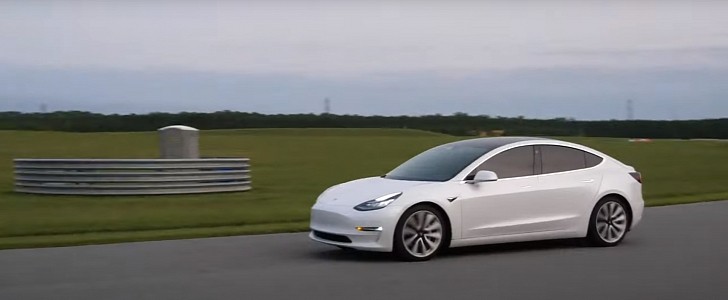Whenever the words "Tesla Model 3" and "racetrack" come up, everybody thinks of the Performance version of the electric sedan, preferably even with the optional Track Package installed.
Previous videos of the Model 3 hitting various tracks around the world - culminating with a Nürburgring outing - have shown why that's actually a pretty good idea. While any other Model 3 trim will handle itself nicely on a circuit thanks to that wonderfully balanced chassis and the power delivery, the car will eventually be held back by other components such as the suspension and, most notably, its brakes.
Like any other EV, the Model 3 is a heavy car compared to its size. High density, you might call it. It has the torque and power to hide it and, in everyday use, even the brakes have it easy by leaving the heavy lifting to the regenerative braking system (using the resistance of the electric motors to slow down the car, thus reducing wear on the actual pads and rotors while recharging the battery at the same time).
On the track, though, you need maximum stopping power, which means the brakes are going to feel the full load of those 3,627 lbs (1,645 kg). And even though that may not seem like much, bear in mind the braking system is designed with the help of the regenerative hardware in mind too so, left on its own, it can feel a little underwhelming.
However, that problem is only going to rear its ugly head after several laps - or one hard lap on the 'Ring - which means you can still take your Model 3 Standard Range, the cheapest Model 3 available, for a quick track session. And, according to Kyle Conner from the One Lap YouTube channel, there are actually plenty of reasons why you might enjoy the rear-wheel-drive Tesla even more than its more powerful dual-motor siblings.
For one thing, it's lighter, and if companies such as Lotus have taught us anything, it's that lightness really matters in these situations. Then, there's also the actual place from where that weight has been removed that plays a part. Since the Standard Range lacks a second motor, that means the front axle is lighter, which translates to better handling and a cleaner turn in feeling.
Finally, the SR version is rear-wheel-drive, and we all know that all-wheel-drive is for performance, whereas RWD is for fun. You won't break any records with the single-motor Model 3, but it will put a grin on your face. Just look at Kyle driving his mom's Tesla in the video below.
Like any other EV, the Model 3 is a heavy car compared to its size. High density, you might call it. It has the torque and power to hide it and, in everyday use, even the brakes have it easy by leaving the heavy lifting to the regenerative braking system (using the resistance of the electric motors to slow down the car, thus reducing wear on the actual pads and rotors while recharging the battery at the same time).
On the track, though, you need maximum stopping power, which means the brakes are going to feel the full load of those 3,627 lbs (1,645 kg). And even though that may not seem like much, bear in mind the braking system is designed with the help of the regenerative hardware in mind too so, left on its own, it can feel a little underwhelming.
However, that problem is only going to rear its ugly head after several laps - or one hard lap on the 'Ring - which means you can still take your Model 3 Standard Range, the cheapest Model 3 available, for a quick track session. And, according to Kyle Conner from the One Lap YouTube channel, there are actually plenty of reasons why you might enjoy the rear-wheel-drive Tesla even more than its more powerful dual-motor siblings.
For one thing, it's lighter, and if companies such as Lotus have taught us anything, it's that lightness really matters in these situations. Then, there's also the actual place from where that weight has been removed that plays a part. Since the Standard Range lacks a second motor, that means the front axle is lighter, which translates to better handling and a cleaner turn in feeling.
Finally, the SR version is rear-wheel-drive, and we all know that all-wheel-drive is for performance, whereas RWD is for fun. You won't break any records with the single-motor Model 3, but it will put a grin on your face. Just look at Kyle driving his mom's Tesla in the video below.







